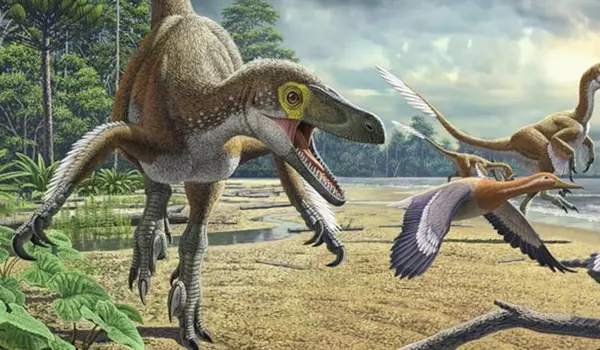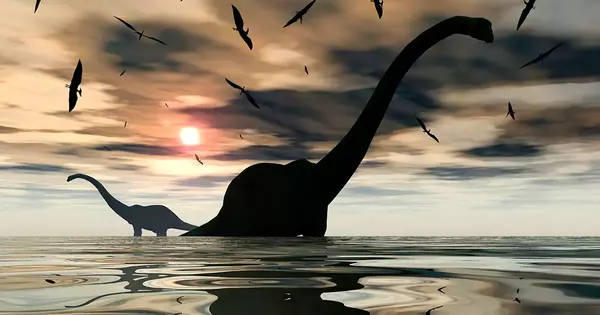The most widely accepted theory for the mass extinction of dinosaurs and other life on Earth is that a large asteroid or comet struck the planet around 66 million years ago, causing a massive global catastrophe. This event is known as the Cretaceous-Paleogene (K-Pg) extinction event. The impact would have created a massive dust cloud that blocked out sunlight, causing a “nuclear winter” effect, which would have killed off many forms of plant and animal life, including the dinosaurs.
Determining what killed the dinosaurs 66 million years ago at the end of the Cretaceous Period has long been a point of contention among scientists as they seek to understand what caused the five mass extinction events that reshaped life on Earth in a geological instant. Some scientists believe that comets or asteroids colliding with Earth were the most likely cause of mass destruction, while others believe that large volcanic eruptions were to blame. Volcanic activity appears to have been the primary driver of mass extinctions, according to a new Dartmouth-led study published in the Proceedings of the National Academy of Sciences (PNAS).
The findings provide the most convincing quantitative evidence to date that the link between major volcanic eruptions and widespread species turnover is not purely coincidental.
According to the researchers, four of the five mass extinctions occurred concurrently with a type of volcanic outpouring known as a flood basalt. In the blink of a geological eye, a million years, these eruptions flood vast areas – even an entire continent – with lava. They leave behind massive fingerprints in the form of step-like igneous rock (solidified from erupted lava) that geologists refer to as “large igneous provinces.”
Our findings suggest that, whether there was an impact or not, there would have been a mass extinction of some magnitude at the Cretaceous tertiary boundary, which can now be demonstrated more quantitatively.
Brenhin Keller
A large igneous province must have at least 100,000 cubic kilometers of magma to be considered large. For comparison, Mount St. Helens’ 1980 eruption involved less than one cubic kilometer of magma. According to the researchers, the majority of the volcanoes represented in the study erupted millions of times more lava than that.
To investigate the temporal relationship between mass extinction and large igneous provinces, the team used three well-established datasets on geologic time scale, paleobiology, and large igneous provinces.
“The large step-like areas of igneous rock from these big volcanic eruptions seem to line up in time with mass extinctions and other significant climatic and environmental events,” says lead author Theodore Green ’21, who conducted this research as part of the Senior Fellowship program at Dartmouth and is now a graduate student at Princeton.
In fact, a series of eruptions in present-day Siberia triggered the most destructive of the mass extinctions about 252 million years ago, releasing a gigantic pulse of carbon dioxide into the atmosphere and nearly choking off all life. Bearing witness are the Siberian Traps, a large region of volcanic rock roughly the size of Australia.
Volcanic eruptions also rocked the Indian subcontinent around the time of the great dinosaur die-off, creating what is known today as the Deccan plateau. This, much like the asteroid strike, would have had far-reaching global effects, blanketing the atmosphere in dust and toxic fumes, asphyxiating dinosaurs and other life in addition to altering the climate on long-time scales.

The theories in favor of asteroid annihilation, on the other hand, rely on the Chicxulub impactor, a space rock that crashed-landed into Mexico’s Yucatan Peninsula around the same time that dinosaurs went extinct, according to the researchers.
“When the Chicxulub impact crater was discovered, all other theories that attempted to explain what killed the dinosaurs, including volcanism, were steamrolled,” says co-author Brenhin Keller, an assistant professor of earth sciences at Dartmouth. Despite decades of exploration, however, he notes that there is very little evidence of similar impact events that coincide with the other mass extinctions.
At Dartmouth, Green set out to find a way to quantify the apparent link between eruptions and extinctions and test whether the coincidence was just chance or whether there was evidence of a causal relationship between the two. Working with Keller and co-author Paul Renne, professor-in-residence of earth and planetary science at the University of California, Berkeley, and director of the Berkeley Geochronology Center, Green recruited the supercomputers at the Dartmouth Discovery Cluster to crunch the numbers.
The researchers compared the best available estimates of flood basalt eruptions with geological timescales of drastic species extinctions, including but not limited to the five mass extinctions. To demonstrate that the timing was not purely coincidental, they tested whether the eruptions would line up just as well with a randomly generated pattern and repeated the experiment with 100 million such patterns. The agreement with extinction periods was found to be far greater than random chance.
“While it is difficult to say whether a specific volcanic outburst caused a specific mass extinction, our findings make it difficult to dismiss the role of volcanism in extinction,” Keller says. Scientists expect that larger eruptions would result in more severe extinctions if a causal link between volcanic flood basalts and mass extinctions is discovered, but such a correlation has not been observed.
Rather than considering the absolute magnitude of eruptions, the research team ranked the volcanic events based on the rate at which lava was ejected. They discovered that the volcanic events with the highest eruptive rates caused the most devastation, resulting in more severe extinctions up to mass extinctions.
“Our findings suggest that, whether there was an impact or not, there would have been a mass extinction of some magnitude at the Cretaceous tertiary boundary, which can now be demonstrated more quantitatively,” Renne says. “The fact that there was an impact undoubtedly exacerbated things.”
The researchers also ran the numbers on asteroids. When the Chicxulub impactor was not considered, the coincidence of impacts with periods of species turnover was significantly weaker, and dramatically worsened, implying that other smaller known impactors did not cause significant extinctions.













